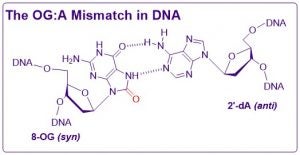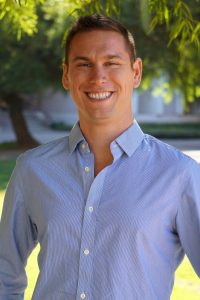Education:
B.S. Chemistry: Biochemistry, Honors, California State University Channel Islands 2016
A.A. General Studies: Natural Sciences, Ventura Community College 2013
Military: Served in the United States Marine Corps as a Rifleman and as Data Network Specialist, 2005-2013
From: Danville, IA
Joined the David Lab: January 2017
Outside of lab: I enjoy hanging out with my daughters and wife, working out, and camping.
Research in David Lab:
The existence of life on earth’s oxygen-rich environment necessitates oxidative DNA repair to maintain genome integrity, and organisms have evolved DNA repair proteins such as MutY to deal with this kind of DNA damage. My research in The David Lab involves determination of the target recognition mechanism of DNA repair protein MutY/MUTYH. Specifically, I am interested in how MutY is able to recognize and locate its target damage mutation, 8-oxo-guanine (8-OG) base-paired with adenine, from amongst the vast amount of undamaged DNA in a cell. MutY specifically cleaves the adenine base from this mutation, allowing for subsequent repair of the mismatch by other enzymes. This DNA damage, when left unrepaired, results in G:C to T:A transversions, damage which will impart far-reaching and devastating effects on an organism. To help answer this question, I am synthesizing an array of systematically modified DNA molecules and examining how MutY/MUTYH binding, kinetics, and cellular repair are affected by specific atomic changes in the modified DNA substrates.

Previous Research Experience:
I previously conducted research in Dr. Ahmed Awad’s Lab of the Chemistry Department at California State University Channel Islands, from 2013 – 2016. My research under Dr. Awad focused on the synthesis of putative antisense oligonucleotides which incorporate a guanidine backbone in place of RNA’s natural phosphodiester backbone. My work saw the synthesis of over 20 nucleoside compounds of varying bases A, U, and G. I additionally screened desired compounds and intermediates as antibacterial agents against 6 strains of bacteria, which led to the discovery of antibacterial activity against Neisseria meningitidis by 6 synthetic compounds. This work was published in Nucleosides, Nucleotides, & Nucleic Acids in 2017.
Van Ostrand, R.; Jacobsen, C.; Delahunty, A.; Stringer, C.; Noorbehesht, R.; Ahmed, H.; Awad, A. M., Synthesis and antibacterial activity of 5′-tetrachlorophthalimido and 5′-azido 5′-deoxyribonucleosides. Nucleosides, Nucleotides and Nucleic Acids 2017, 36 (3), 181-197.
Keywords: #ModifiedNucleosides #ModifiedOligonucleotides #NucleosideChemistry #OrganicSynthesis #Synthesis #DNARepair #DNA #Muty #Mutyh #8OG #DavidLab #UCDavis #UndergraduateResearch #TeachingAssistant #Chemistry #NMR #RobertVanOstrand #robertucdavis
